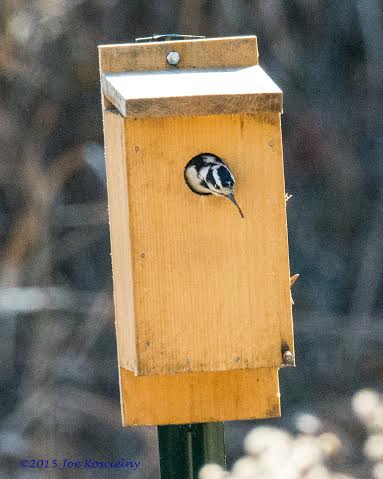New couples are finding it very hard to find suitable housing in the Garden State this year . Commercialization and urban sprawl are making life tough for these families to locate places where they can settle down and raise their young . There is stiff competition for housing that already exists and unless they can find help these families may have to seriously think twice about raising a family and bringing forth their next generation here in New Jersey.
The housing shortage I speak of occurs in all our own towns and cities and backyards and parks. It is our birds that are in serious need of some housing this Spring.
- Credit BCAS
All of us who have grown up in New Jersey have witnessed firsthand the devastating loss of natural wildlife habitat right in our own neighborhoods. As kids we had ponds, or maybe a patch of woods or a grassy meadow that we loved to play in. But take a look around your town now. Where have they gone ? They are now a shopping mall, a housing development or a parking lot. And now try to imagine if you are a bird returning to those places in the Spring in search of a place to nest. Where do you go?
Natural habitat disappears as more trees are lost to the bulldozer and storms, and cut down just because they no longer fit into a landscape design. As a result our local birds, especially cavity nesters such as Woodpeckers , Chickadees , Bluebirds and Screech Owls, find it more difficult each year to find suitable nesting sites. Add competition from invasive House Sparrows and Starlings and that leaves these birds in a most precarious situation to say the least. But there are some things we can do to help .
Keep up dead snags !
Dead or dying trees are a very important part of our ecosystem and provide not only food but premium nesting sites to birds such as White-breasted Nuthatch, Tufted Titmouse and Pileated Woodpeckers , but unfortunately sometimes these snags are a threat to our homes and must be removed. But if possible and as long as it is safe,leave 8 or 10 feet of the old tree standing. This will help provide nesting places to our many bird species and help keep our backyard ecosystem in balance.
Provide nest boxes
Without manmade nesting places, birds such as Tree Swallows, which for the most part only survive in the Meadowlands because of manmade birdboxes, would find it hard if not impossible to find nesting places here in New Jersey . House Wrens, Chickadees and Flickers have also come to depend on the manmade nest boxes placed in the backyard or local nature center.
Use the Right Nest Box in The Right Place!
Placing the right birdhouse in your backyard is critical if you want to encourage birds to make your backyard their home. Just because you put up a bluebird house does not mean you will get a bluebird to take up residence. To do it right you will need to match the right nestbox to the correct habitat. By all means if you have a Bluebird habitat, which is large open fields, then go for it. But if your yard is like most of suburbia then you may have more success inviting Black-capped Chickadees and House Wrens into your backyard habitat.
If you are located in a more wooded area, birds like White-breasted Nuthatches and Red-bellied Woodpeckers may be added to your list. Depending on the species, some birdhouses can be hung from a tree branch with success and others will need to be placed right on the trunk of the tree, and still others will need to go very high up or will need to be close to water. It depends on the habitat and the species you are trying to provide a home for.
Although there is still snow on the ground and the winter winds still blow, Spring will be here in just a few weeks and birds will begin arriving as soon as March, looking for a place to bring forth the next generation. Unfortunately, man has vastly and forever altered our natural landscape, and it is up to us to do what we can to compensate our birds for the damage done . We cannot make up for the vast loss of habitat, but putting up a nest box this spring means one more family of birds will have a better chance to survive and carry on to the next generation
For more information about nesting boxes go to http://nestwatch.org/learn/all-about-birdhouses/



